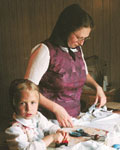Unique and very different from the Amish, the Hutterites are a communal group of families and individuals, living on large farms, called colonies. They trace the beginning of their religious group back to Europe in the early 16th century, in Germany and Switzerland. Like the Amish, they speak German to each other and in their church services.

The Hutterites have a communal lifestyle, so while everyone eats all their meals in the large dining halls (separate dining rooms for children and adults) each family also has their own apartment. The women tend to the cooking, sewing and gardening, assigning chores on a rotation basis. All work and income is shared by the 65 to 140 people living in the colony. They have very few converts, but retention is high, so when the colony gets too large, they split into two colonies, and half the people move to the new colony and get another large farm establishment going. There are over 400 Hutterite colonies in the USA and Canada.
Everything is owned communally, which means that all the income from their different businesses belongs to everyone on the colony. If a member needs something, they ask the group for it, and if it is something that is necessary for either that individual or for them to accomplish their job, it is bought for them. Most items are given out according to need. Entrepreneurship and trying to earn personal spending money is greatly discouraged. Any personal items they might have in their apartments are provided by the colony, or were items that the colony gave permission for them to have. If you are looking for a beautiful Amish quilt, the Hutterite colonies would not be the place to look, as utilitarian seems to be the key to their society.
Hutterites are fluent in three languages: Hutterisch, (a German dialect); German; and English. The young children, ages 3 - 6, attend kindergarten which is taught by one of the grandmothers with a couple of the younger women to help her. The older children attend the colony school, and have daily German classes which are held before or after their regular schoolwork begins. The older children also attend Sunday School every Sunday afternoon. Church is held usually before the evening meal (every day), and is conducted in German. Saturday night is family singing night, and the Sunday morning church service is about 90 minutes long. TV and radios are not allowed in the community.

Hutterites maintain a dress code where the men wear black or dark trousers with suspenders, and any kind of buttoned shirt. Married men wear a beard. Women wear below-knee-length dresses; younger women and girls wear brighter colored dresses than the older women do. Women also wear a black, polka-dot headcovering, like a kerchief (which has become their trademark). Rather than creating the intricate and beautiful Amish quilts known in other Plain communities, the Hutterites sew pieced comforters that are then knotted (instead of quilted) for everyday use.
Today Hutterites are found in the western provinces of Canada. In the US they are in the Midwest and in North and South Dakota, Minnesota, Washington and Montana.
